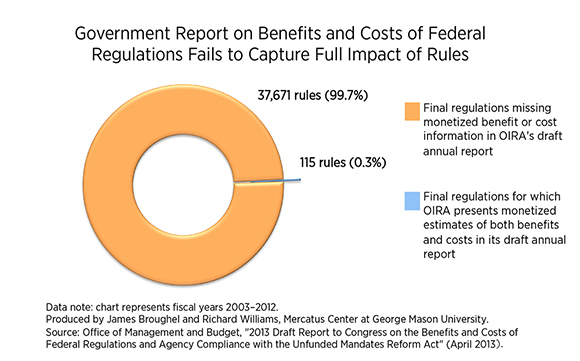- | Regulation Regulation
- | Data Visualizations Data Visualizations
- |
Government Report on Benefits and Costs of Federal Regulations Fails to Capture Full Impact of Rules
OIRA’s most recent draft report for fiscal year 2003 through 2012 estimated that the major regulations the agencies evaluated would produce benefits ranging from $192.7 to $799.7 billion (2001$), at a cost of $56.6 to $83.7 billion (2001$).
Each year, the Office of Information and Regulatory Affairs (OIRA) produces a report on the benefits and costs of federal regulations, using Regulatory Impact Analyses (RIAs) created by federal agencies. The OIRA report and the underlying agency RIAs together provide an estimate of the effects regulations are likely to have on the economy upon implementation.
OIRA’s most recent draft report for fiscal year 2003 through 2012 estimated that the major regulations the agencies evaluated would produce benefits ranging from $192.7 to $799.7 billion (2001$), at a cost of $56.6 to $83.7 billion (2001$).
While at first glance it might appear the regulatory system is working well for the American public, these numbers are misleading. As required by presidential executive order, agencies must present an assessment of the potential benefits and costs for all regulations that are deemed to be significant by the Administrator of OIRA. There were 3,203 significant rules reviewed by OIRA in FY2003–FY2012. Within this group, OIRA presents dollar estimates of benefits and costs for only a small fraction of the total regulations the agency reviewed. Of 37,786 rules finalized in FY2003–FY2012, only 115 rules had estimates of monetized benefits and costs in OIRA’s draft report. This is less than one-third of one percent of all final regulations, an abysmal record. Even worse, there are no rules in the report from independent regulatory agencies that have dollar estimates for both benefits and costs.
Furthermore, even though many of the regulations promulgated by agencies are not “significant” in nature (i.e., their impact on the economy is less than $100 million in any given year), the aggregate effects of thousands of these “nonsignificant” regulations being implemented year after year can be substantial, and agencies should make an effort to measure these effects.
A snapshot of a very small number of regulations may imply the US regulatory system is better than it is. Until we have estimates of benefits and costs for all regulations produced on an annual basis, however, OIRA’s benefit and cost figures produce little meaningful information for the public.

